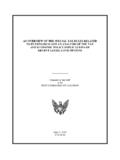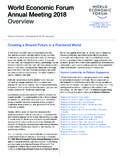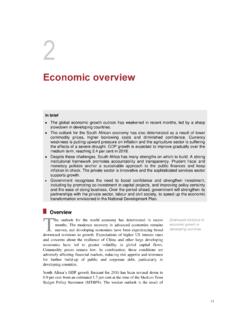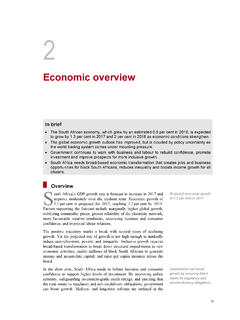Transcription of OECD Economic Surveys: India 2017
1 OECD Economic Surveys India February 2017 overview This overview is extracted from the 2017 Economic survey of India . The survey was discussed at a meeting of the Economic and Development Review Committee which is charged with the examination of the Economic situation of member and key partner countries, and is published on the responsibility of the Secretary General of the OECD. This document and any map included herein are without prejudice to the status of or sovereignty over any territory, to the delimitation of international frontiers and boundaries and to the name of any territory, city or area OECD Economic Surveys: India OECD 2017 You can copy, download or print OECD content for your own use, and you can include excerpts from OECD publications, databases and multimedia products in your own documents, presentations, blogs, websites and teaching materials, provided that suitable acknowledgment of OECD as source and copyright owner is given.
2 All requests for public or commercial use and translation rights should be submitted to Requests for permission to photocopy portions of this material for public or commercial use shall be addressed directly to the Copyright Clearance Center (CCC) at or the Centre fran ais d exploitation du droit de copie (CFC) at OECD Economic Surveys: India OECD 2017 Executive summary Growth has been strong Tax reform could make growth more inclusive Policy reforms at the state and municipal levels could boost productivity andreduce spatial disparities1 EXECUTIVE SUMMARYOECD Economic SURVEYS: India OECD 2017 Growth has been strongAnnualised average increase 2014-2016Q3 Source:Central Statistics Organisation; and OECD EconomicOutlook 100 2 growth of around 7 % makes India thefastest-growing G20 economy.
3 The acceleration ofstructural reforms, the move towards a rule-basedpolicy framework and low commodity prices haveprovided a strong growth impetus. Recent deregulationmeasures and efforts to improve the ease of doingbusiness have boosted foreign investment. Investmentis still held back by the relatively high corporate incometax rates, a slow land acquisition process, regulationswhich remain stringent in some areas, weak corporatebalance sheets, high non-performing loans which weighon banks lending, and infrastructure job creation has been low, held back by complexlabour reform could make growth more inclusiveTax revenue, 2015 or latest year availableNote:Tax revenue includes social security :OECD Economic Outlook 100 database; OECD RevenueStatistics database; World Bank; Reserve Bank of India ; CentralStatistics 2 comprehensive tax reform would promoteinclusive growth.
4 Timely and effective implementationof the Goods and Services Tax would supportcompetitiveness, investment and Economic s plans to reduce the corporate income taxrate and broaden the base will serve the sameobjectives. These two on-going reforms have beendesigned to be revenue-neutral while India needs toraise additional tax revenue to meet social and physicalinfrastructure needs. Property and personal incometaxes, which are paid by very few people, could bereformed to raise more revenue, promote social justiceand empower sub-national governments to betterrespond to local needs. Ensuring clarity and certainty intax legislation and employing more skilled tax officerswould strengthen the tax administration and make thesystem fairer and more reforms at the state and municipal levels could boost productivity and reducespatial disparitiesInequality in GDP per capita across regions,2013 or latest year availableSource:OECD Regional 2 disparities in living standards are large.
5 Indiais reforming relations across levels of government toempower the states and make policies more responsive tolocal conditions. Some states have taken the lead inimproving the ease of doing business and now enjoyhigher productivity and income. Additional efforts toshowcase reform efforts at the state level and identify bestpractices will support the reform process and help achievebetter and balanced regional development. In rural areas,poverty rates are high and access to core public services isoften poor. Farm productivity is low owing to small andfragmented land holdings, poor input management, andinefficient market conditions. In urban areas,agglomeration benefits are quickly reduced by congestioncosts, in particular air pollution and long commutingtimes, all of which reduce AfricaChileMexicoColombiaTurkeyIndonesia ChinaIndiaY-o-y % increase0510152025303540 IndonesiaRussiaIndiaChinaMexicoChileColo mbiaSouthAfricaTurkeyBrazilOECD% of AfricaOECDT urkeyChinaIndiaBrazilMexicoRussiaChileCo lombiaIndonesiaGini index2 EXECUTIVE SUMMARYOECD Economic SURVEYS: India OECD 2017 MAIN FINDINGSKEY RECOMMENDATIONSS trengthening macroeconomic resilience and growthDespite fiscal consolidation at the central government leveland strong Economic growth, the government debt to GDPratio has increased.
6 Spending needs on key physical andsocial infrastructure are not fully met. Ensure that government debt to GDP returns to a decliningpath. Increase public spending on physical and socialinfrastructure and gradually extend the subsidy reform toother products, including fertilisers and food. Raise more revenue, especially from property and personalincome to prudent monetary policy, inflation has declinedbut monetary policy transmission has been slow andincomplete, partly reflecting large non-performing loans andregulations imposed on banks. Strengthen public bank balance sheets by recapitalisingthem, promoting bank consolidation and lowering the 51%threshold below which the government share cannot fall. Gradually reduce the obligations imposed on banks to holdpublic bonds and lend to priority sectors.
7 Monetary policy should continue to be creation in the organised sector has been participation is low and many young people are outof work and not in education or training. Labour regulationsare complex and become more stringent as companiesemploy more workers. A large number of workers,particularly in the unorganised (informal) sector, are notcovered by core labour laws and social insuranceprogrammes. Introduce a simpler and more flexible labour law whichremoves disincentives for firms to create jobs. Continue improving access to education and provide betterand earlier vocational training. Foster competition among states in the ease of creatingjobs. Produce timely data on employment to help designbetter well-being of people and corporate investment are heldback by infrastructure bottlenecks, in particular in electricityprovision and water sanitation.
8 Upgrade electricity and water infrastructure and provideaccess to all. Set energy and water prices high enough to cover economiccosts for investors, replacing subsidies by better targetedhousehold financial a comprehensive tax reform to boost inclusive growthThe tax-to-GDP ratio is low and the tax system has littleredistributive impact. Few people pay income taxes andproperty taxes are low. Meeting social and developmentneeds will require raising more revenue from property andpersonal income taxes. Remove the tax expenditures that benefit the rich most andfreeze the income thresholds from which rates apply. Enable municipalities to raise more real estate corporate income tax rates and a narrow base distortthe allocation of resources, discourage foreign investmentand make tax evasion and avoidance more attractive.
9 Taxdisputes are frequent and long to resolve. Staff numbers andtraining levels are low in the tax administration. Implement the gradual reduction in the corporate incometax from 30% to 25% while broadening the tax base. Provide certainty regarding tax rules and theirimplementation. Increase the number and training of staff employed in thetax a strong and balanced regional developmentPoverty in rural areas is high, particularly among marginalfarmers and landless labourers and many farmers operateon very small land plots. Enable reforms in land ownership laws, improve the landregistry and step up the digitisation of land records. Improve infrastructure to provide non-farm activitiesgreater push both in rural and urban areas.
10 Continue efforts to improve access to core public servicesfor in productivity, consumption and access to publicservices across states is large. States that have low regulatoryand administrative barriers perform better. Continue the benchmarking of states and strengthen thesharing of best practices, in particular on labour regulationsand land population will increase fast. Urban citizens sufferfrom poor urban infrastructure, transport congestion and airpollution. Give municipalities more and clearer spending and taxingpowers. Rely more on road pricing and parking fees to increasemunicipal revenue, restrain private car usage and Economic Surveys: India OECD 2017 Assessment and recommendations Strong growth has raised incomes and reduced poverty but inequalities remain India is growing fast, but private investment is weak Monetary, financial and fiscal policies to set the foundation for stronger growth A comprehensive tax reform to promote inclusive growth Promoting stronger and more inclusive growth Achieving strong and balanced regional development4 ASSESSMENT AND RECOMMENDATIONSOECD Economic SURVEYS.


















